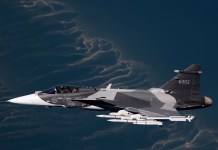As drone technology is getting more and more sophisticated, armies around the world have started exploring technologies, which could enable them to intercept enemy UAVs and even target rogue drones. And Russia is among the nations that seem to have achieved some success.
US Navy Grounds Entire Fleet Of Unmanned MQ-8C Choppers ‘Fire Scout’ After Two Accidents In A Week
As drone swarming techniques and anti-drone weapons pick up the pace, Russia has come up with a non-destructive way of catching UAVs.
The interceptor drone is developed by Vega Company of Ruselectronics Group, which is a part of the state-owned Rostec corporation. It is looking to patent the drone capable of capturing targets with a special net, reported Russian news agency, Tass.
According to the report, the registered application says that the interceptor drone “consists of the body frame with at least two engines with variable angles of rotation placed along its perimeter.” Its specific feature is “an aerodynamic structure consisting of a catching net is integrated into the frame’s hollow space.”
The Tass report further explained that the net’s size and surface tension allow for capturing and retaining the target while the net’s tension is regulated by turning an automatic coil winder to change the length of the line stretched along the frame’s perimeter and holding the net with the captured object.
Analysts believe that such a drone would reduce the chances of destruction and debris falling on the ground, and is suitable for carrying out operations in urban and widely populated areas.
Is Russia The First One?
While the idea behind Russia’s interceptor drone with a net is uncommon but it isn’t new. Four years ago, researchers from Michigan Technological University developed a “drone-catcher” with a similar net configuration to catch rogue drones.
Mo Rastgaar, an associate professor of mechanical engineering at Michigan Technological University (MTU), and the brain behind the drone got the idea while watching World Cup soccer. He realized that the snipers are protecting the crowd. “I thought, ‘if the threat is a drone, you really don’t want to shoot it down—it might contain explosives and blow up. What you want to do is catch it and get it out of there,” he said in a news release.
The video released by Human Interactive Robotics (HiRo) Lab of MTU shows the drone launching a net attached by a string and the system could be “autonomous, controlled by a ground-based human pilot or a combination of the two.” After spotting the rogue or intruder drone, the system tracks and follows it and launches the net at it from a distance of up to 40 feet.
“Because the net is so big and can be deployed so quickly, it can overwhelm even the fastest, most maneuverable small drone,” said the news release.
Rastgaar wanted to build a drone catcher that would capture rogue drones threatening military installations, air traffic, and sporting events. He emphasized that the net is attached to the catcher which can retrieve the rogue drone or drop it in a designated secure area.
The Tokyo police have also been using drone catching net, although instead of a configured net-launching system, they use an unmanned aerial vehicle attached with a net to capture rogue drones.
Reportedly, its purpose is to capture suspicious drones trying to enter government buildings and other drone-restricted areas like airports. In 2015, Tokyo police set up a drone squad to locate and capture suspicious UAVs. The decision was taken after an incident when a drone carrying a small amount of radioactive sand landed on the roof of the Japanese Prime Minister’s office.
Author’s Profile: https://eurasiantimes.com/author/smritiatchaudhary0191/
Email: smriti.chaudhary02@gmail.com
Follow EurAsian Times on Google




